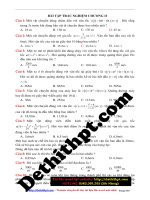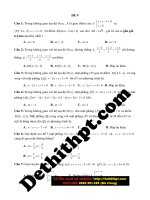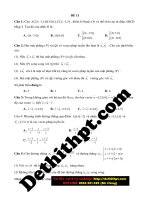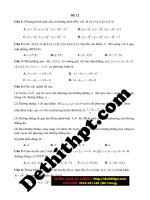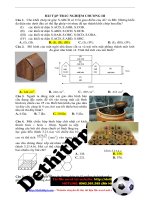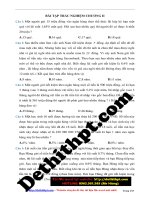Đề 34 image marked image marked
Bạn đang xem bản rút gọn của tài liệu. Xem và tải ngay bản đầy đủ của tài liệu tại đây (1.97 MB, 7 trang )
Exercise 34:
Read the following passage and mark the letter A, B, C or D to indicate the correct answer to each
of the questions.
Harvard University, today recognized as part of the top echelon of the world's universities, came
from very inauspicious and humble beginning.
This oldest of American universities was founded in 1636, just sixteen years after the Pilgrims
landed at Plymouth. Included in the Puritan emigrants to the Massachusetts colony during this period
were more than 100 graduates of England's prestigious Oxford and Cambridge universities, and these
universities graduates in the New Word were determined that their sons would have the same educational
opportunities that they themselves had had. Because of this support in the colony for an institution of
higher learning, the General Court of Massachusetts appropriated 400 pounds for a college in October of
1636 and early the following year decided on a parcel of land for the school; this land was in an area
called Newetowne, which was later renamed Cambridge after its English cousin and is the site of the
present-day university.
Đăng ký file Word tại link sau
/>
When a young minister named John Harvard, who came from the neighboring town of Charlestown,
died from tuberculosis in 1638, he willed half of his estate of 1,700 pounds to the fledgling college. In
spite of the fact that only half of the bequest was actually paid, the General Court named the college after
the minister in appreciation for what he had done. The amount of the bequest may not have been large,
particularly by today's standard, but it was more than the General Court had found it necessary to
appropriate in order to open the college. Henry Dunster was appointed the first president of Harvard in
1640, and it should be noted that in addition to serving as president, he was also the entire faculty, with an
entering freshmen class of four students. Although the staff did expand somewhat, for the first century of
its existence the entire teaching staff consisted of the president and three or four tutors.
Trang 1
QUESTION
Question 1: The main idea of this passage is that ____________.
A. Harvard is one of the world's most prestigious universities
B. what is today a great university started out small
C. John Harvard was key to the development of a great university
D. Harvard University developed under the auspices of the General Court of Massachusetts
Question 2: The passage indicates that Harvard is ______.
A. one of the oldest universities in the world
B. the oldest university in the world
C. one of the oldest universities in America
B. the oldest university in America
Question 3: It can be inferred from the passage that the Puritans who traveled to the Massachusetts
colony were ________.
A. rather well educated
B. rather rich
C. rather supportive of the English government
D. rather undemocratic
Question 4: The pronoun "they" in paragraph 2 refers to _____.
A. Oxford and Cambridge universities
B. university graduates
C. sons
D. educational opportunities
Question 5: The word "pounds" in paragraph 2 are probably _____.
A. types of books
B. college students
C. units of money
D. school campuses
Question 6: The word "English cousin" in paragraph 2 refers to a. ______.
A. city
B. relative
C. person
D. court
Question 7: Which of the following is NOT mentioned about John Harvard?
A. What he died of
B. Where he came from
C. Where he was buried
D. How much he bequeathed to Harvard
Trang 2
Question 8: The word "fledgling" in paragraph 3 could best be replaced by which of the following?
A. Newborn
B. Flying
C. Winged
D. Established
Question 9: The passage implies that _____.
A. Henry Dunster was an ineffective president
B. someone else really served as president of Harvard before Henry Dunster
C. Henry Dunster spent much of his time as president managing the Harvard faculty
D. the position of president of Harvard was not merely an administrative position in the early years.
Question 10: The word "somewhat" in paragraph 3 could best be replaced by ______
A. back and forth
B. to and fro
C. side by side
D. more or less
GIẢI CHI TIẾT
Question 1: The main idea of this passage is that__________.
A. Harvard is one of the world's most prestigious universities
B. what is today a great university started out small
C. John Harvard was key to the development of a great university
D. Harvard University developed under the auspicies of the General Court of Massachusetts
Dịch nghĩa: Ý chính của đoạn văn trên là______.
A. Harvard là một trong những trường đại học uy tín bậc nhất trên thế giới
B. Ngày nay nó là một trường đại học lớn nhưng lại bắt đầu từ cái rất nhỏ
C. John Harvard là nhân tố quan trọng đối với sự phát triển của một trường đại học lớn
D. Đại học Harvard phát triển dưới sự nâng đỡ của Tòa án bang Massachusetts
Giải thích: đọc ngay câu đầu tiên: "Harvard University, today recognized as part of the top echelon of the
world's universities, came from very inauspicious and humble beginnings" (Đại học Harvard, ngôi trường
mà ngày nay được công nhận là một trong những đại học hàng đầu thế giới, đi lên từ những khởi đầu tầm
thường và khiêm tốn)
Question 2: The passage indicates that Harvard is _________.
A. one of the oldest universities in the world
B. the oldest university in the world
C. one of the oldest universities in America
D. the oldest university in America
Trang 3
Dịch nghĩa: Đoạn văn chỉ ra rằng Harvard là __.
A. một trong những đại học lâu đời nhất thế giới
B. là đại học lâu đời nhất trên thế giới
C. là một trong những đại học lâu đời nhất nước Mĩ
D. là đại học lâu đời nhất nước Mĩ
Giải thích: Đọc câu đầu đoạn 2 "This oldest of American universities was founded in 1636" (Đây là
trường đại học lâu năm nhất ở Mĩ được thành lập năm 1636)
Question 3: It can be infered from the passage that the Puritans who traveled to the Massachusetts colony
were _______________.
A. rather well educated
B. rather rich
C. rather supportive of the English goverment
D. rather undemocratic
Dịch nghĩa: Có thể suy ra từ đoạn văn là những người Puritans người mà chuyển tới thuộc địa
Massachusetts đều ____
A. được giáo dục khá tốt
B. khá giàu có
C. khá ủng hộ chính phủ Anh
D. không dân chủ
Giải thích: "Included in the Puritans emigrants to the Massachusetts colony during this period were
more than 100 graduates of England's prestigious Oxford and Cambridge universities"
(Trong số những người Puritan di cư đến thuộc địa Massachusetts trong suốt thời gian đó có hơn 100
người tốt nghiệp từ những trường danh tiếng ở Anh như Oxford và Cambridge)
Question 4: The pronoun "they" in paragraph 2 refers to_______.
A. Oxford and Cambridge universities
B. university graduates
C. son
D. educational oppottunities
Dịch nghĩa: Đại từ "they" ở đoạn 2 chỉ________.
A. đại học Oxford và Cambridge
B. những người tốt nghiệp đại học
C. những đứa con trai
D. những cơ hội giáo dục
Giải thích: "these university graduates in the New World were determined that their sons would have the
same educational oppotunities that they themselves had had" (những người tốt nghiệp đại học này đã
quyết định rằng con trai của họ cũng sẽ được hưởng sự giáo dục như họ có)
Question 5: The word "pounds" in paragraph 2 are probably ____.
A. types of books
B. college students
C. units of money
D. school campuses
Trang 4
Dịch nghĩa: Từ "pounds" ở đoạn 2 có thể là____.
A. những loại sách
B. những sinh viên đại học
C. những đơn vị tiền tệ
D. những khu sân trường
Giải thích: pound là một đơn vị tiền tệ của Anh
Question 5: The word "pounds" in paragraph 2 are probably ________.
A. types of books
B. college students
C. units of money
D. school campuses
Dịch nghĩa: Từ "pounds" ở đoạn 2 có thể là____.
A. những loại sách
B. những sinh viên đại học
C. những đơn vị tiền tệ
D. những khu sân trường
Giải thích: pound là một đơn vị tiền tệ của Anh
Question 6: The word "English cousin" in paragraph 2 refers to a_________.
A. city
B. relative
C. person
D. court
Dịch nghĩa: Từ "English cousin" ở đoạn 2 chỉ một _____.
A. thành phố
B. người thân
C. người nào đó
D. tòa án
Giải thích: "this land was in an area called Newetowne, which was later renamed Cambridge after its
English cousin and is the site of the present-day university" (phần đất này được gọi là Newetowne, nơi mà
sau đó được đổi tên thành Cambridge giống như một thành phố của Anh và đó cũng chính là vị trí của
trường ngày nay)
Question 7: Which of the following is NOT mentioned about John Harvard?
A. What he died of
B. Where he was buried
C. Where he came from
D. How much he bequeathed to Harvard
Dịch nghĩa: Trong những thông tin sau, thông tin nào không được đề cập về John Harvard?
A. Ông ta chết vì cái gì
B. Nơi ông ấy được chôn cất
C. Ông ấy đến từ đâu
D. ông ấy đã đóng góp như thế nào cho Harvard
Giải thích: "When a young minister named John Harvard, who came from the neighboring town of
Chalestowne, died from tuberculosis in 1638, he willed half of his estate of 1700 pounds to the fledging
college" (Khi bộ trưởng trẻ là John Harvard, người đến từ thị trấn gần với Charlestowne chết vì căn bệnh
lao phổi vào năm 1638, ông ấy để lại di chúc là sẽ dành một nửa tài sản trong 1700 pounds cho ngôi
trường còn non trẻ này)
Trang 5
Question 8: The word "fledgling" in paragraph 3 could best be replaced by which of the following?
A. Newborn
B. Flying
C. Winged
D. Established
Dịch nghĩa: Từ "fledgling" ở đoạn 3 có thể được thay thế bởi từ nào trong các từ sau?
A mới sinh, mới thành lập
B. Bay
C. Cất cánh
D. Thành lập
Giải thích: fledgling: non nớt, mới mẻ
Question 9: The passage implies that _________.
A. Henry Dunster was an ineffective president
B. Someone else really served as president of Harvard before Henry Dunster
C. Henry Dunster spent much of his time as president managing the Harvard faculty
D. the position of president of Harvard was not merely an administrative position in the early years
Dịch nghĩa: Đoạn văn ngụ ý rằng ____________.
A Henry Dunster là một hiệu trưởng không hiệu quả
B. Một số người khác là hiệu trưởng của Harvard trước Henry Dunster
C. Henry Dunster dành rất nhiều thời gian của ông ấy trong vai trò là hiệu trưởng để quản lí Harvard
D. Vị trí hiệu trưởng của Harvard không chỉ là vị trí điều hành trong những năm đầu
Giải thích: "Henry Dunster was appointed the first president of Harvard in 1640, and it should be noted
that in addition to serving as president, he was also the entire faculty, with an entering freshman class of
four students" (Henry Dunster được bổ nhiệm là hiệu trưởng đầu tiên của Harvard vào năm 1640 và nói
thêm rằng không chỉ là hiệu trưởng, ông cũng là toàn bộ đội ngũ giảng viên, với lớp học gồm bốn sinh
viên năm nhất)
Question 10: The word "somewhat" in paragraph 3 could best be replaced by
A. back and forth
B. to and fro
C. side by side
.
D. more or less
Dịch nghĩa: Từ "somewhat" ở đoạn 2 có thể thay thế bởi ___.
A tới lui
B. tới lui
C. cùng sát cánh
D. một chút
Giải thích: somewhat = a little = practically = more or less: một chút, một phần nào đó
Trang 6
DỊCH BÀI
Đại học Harvard, ngôi trường mà ngày nay được công nhận là một trong những đại học hàng đầu
thế giới đi lên từ những khởi đầu tầm thường và khiêm tốn.
Đây là một trong những trường đại học lâu năm nhất ở Mĩ được thành lập năm 1636, chỉ 16 năm sau
khi những người hành hương đặt chân đến Plymouth. Trong số những người Puritan di cư đến thuộc địa
Massachusetts vào thời gian này có hơn 100 người tốt nghiệp từ những trường danh tiếng ở Anh như
Oxford và Cambridge và những người tốt nghiệp đại học này đã quyết định rằng con trai của họ cũng sẽ
được hưởng sự giáo dục như họ. Vì sự ủng hộ cho một môi trường học tập ở trình độ cao hơn nên hội
đồng bang Massachusetts đã trích 400 pounds để thành lập một trường cao đẳng vào tháng 10 năm 1636
và ngay đầu năm sau đã quyết định dành một phần đất cho trường này - phần đất này được gọi là
Newetowne, sau đó được đổi tên thành Cambridge giống như một thành phố của Anh và nó cũng chính là
vị trí của trường này nay.
Khi một vị bộ trưởng trẻ là John Harvard, người đến từ một thị trấn gần với Charlestowne chết vì
căn bệnh lao phổi vào năm 1638, ông đã để lại di chúc là sẽ dành một nửa trong khối tài sản 1700 pounds
để phát triển ngôi trường này. Mặc dù thực tế thì chỉ một nửa số tiền theo di chúc được trả, Hội đồng bang
vẫn đặt tên cho ngôi trường theo tên của người bộ trưởng đó để tri ân những điều ông đã làm cho trường.
Lượng tài sản đó không lớn, đặc biệt với tiêu chuẩn ngày nay nhưng nó là nhiều hơn so với số tiền mà
Hội đồng bang cho là cần thiết để thành lập một trường đại học. Henry Dunster được bổ nhiệm là hiệu
trưởng đầu tiên của Harvard vào năm 1640 và nói thêm rằng không chỉ là hiệu trưởng, ông cũng là toàn
bộ đội ngũ giáo viên nhà trường với một lớp học gồm có bốn sinh viên năm nhất. Mặc dù đội ngũ giảng
viên cũng được mở rộng phần nào đó nhưng trong thế kỉ đầu tiên kể từ ngày thành lập, toàn bộ đội ngũ
giảng viên của trường chỉ gồm có hiệu trưởng và 3 hay 4 giảng viên khác.
Trang 7
